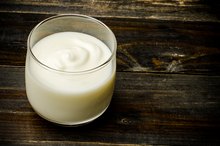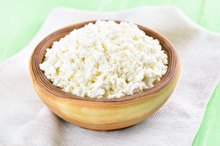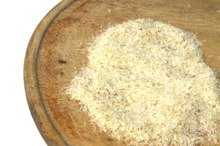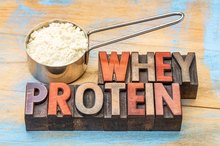What does fact checked mean?
At Healthfully, we strive to deliver objective content that is accurate and up-to-date. Our team periodically reviews articles in order to ensure content quality. The sources cited below consist of evidence from peer-reviewed journals, prominent medical organizations, academic associations, and government data.
The information contained on this site is for informational purposes only, and should not be used as a substitute for the advice of a professional health care provider. Please check with the appropriate physician regarding health questions and concerns. Although we strive to deliver accurate and up-to-date information, no guarantee to that effect is made.
Casein and Lactose
The milk you drink contains a variety of vitamins and minerals, as well as protein and sugar. One of the most abundant proteins in milk is casein. The simple sugar lactose provides most of the natural sugar content of milk. While most people can drink milk without a problem, some people experience abnormal reactions after consuming casein or lactose.
Casein
There are two major proteins in milk: whey and casein. Whey is the protein in the liquid portion of the milk that is left after milk curdles. Casein is the protein in the solid portion of curdled milk, often referred to as the curd. The term "casein" refers to several protein substances. Each of these substances has its own amino acid structure and function. Casein proteins contain phosphate, which allows calcium to bind to the protein. As a result, casein is what gives milk most of its calcium content.
- There are two major proteins in milk: whey and casein.
- Casein is the protein in the solid portion of curdled milk, often referred to as the curd.
Lactose
Lactose & Itching
Learn More
Lactose is a type of simple carbohydrate called a disaccharide, which means it contains two sugars joined together. The simple sugars galactose and glucose make up lactose, often referred to as milk sugar. According to the Virtual Chembook at Elmhurst College, the lactose content of cow’s milk ranges from 4 percent to 6 percent. Your body cannot absorb lactose in its full form.
- Lactose is a type of simple carbohydrate called a disaccharide, which means it contains two sugars joined together.
- The simple sugars galactose and glucose make up lactose, often referred to as milk sugar.
Milk Allergy
A milk allergy is characterized by an abnormal immune reaction to the milk proteins 2. You may be allergy to casein, whey or both of the proteins. When you consume milk, your body identifies the milk protein as a potentially harmful substance and sets off a reaction that sends out antibodies called immunoglobulin E, or IgE, to attack the milk proteins. IgE also triggers your body to release a chemical compound called histamine that causes widespread inflammation. This inflammation causes the symptoms most commonly associated with allergy, which include hives, wheezing, vomiting, runny nose, watery eyes, itchy skin, diarrhea and abdominal cramps.cause:
- This inflammation causes the symptoms most commonly associated with allergy
- which include hives
- wheezing
- vomiting
- runny nose
- watery eyes
- itchy skin
- diarrhea
- abdominal cramps
- A milk allergy is characterized by an abnormal immune reaction to the milk proteins 2.
- When you consume milk, your body identifies the milk protein as a potentially harmful substance and sets off a reaction that sends out antibodies called immunoglobulin E, or IgE, to attack the milk proteins.
Lactose Intolerance
Dairy Allergy & Nausea
Learn More
Lactose intolerance is an inability to properly digest the milk sugar lactose. Lactose intolerance differs from a milk allergy in that it does not involve the immune system 2. If you are lactose intolerant, your small intestine does not produce enough of the enzyme lactase to properly break down lactose. As a result, lactose moves through your digestive system in its full form. When it reaches the bacteria that live in your large intestine, the bacteria feed on it, which causes the common symptoms of lactose intolerance. These symptoms include abdominal pain, bloating, gas, diarrhea and nausea.
- Lactose intolerance is an inability to properly digest the milk sugar lactose.
- When it reaches the bacteria that live in your large intestine, the bacteria feed on it, which causes the common symptoms of lactose intolerance.
Related Articles
References
- Elmherst College: Carbohydrates -- Lactose
- MayoClinic.com: Milk Allergy
- Boyce JA et al. Guidelines for the Diagnosis and Management of Food Allergy in the United States: Report from the NIAID-sponsored Expert Panel. J Allergy Clin Immunology. 2010.
- Food Allergy Research and Education (FARE) http://www.foodallergy.org/allergens/milk-allergy
Writer Bio
Lindsay Boyers has a Bachelor of Science in nutrition from Framingham State College and a certificate in holistic nutrition from the American College of Healthcare Sciences. She is also a licensed aesthetician with advanced training in skincare and makeup. She plans to continue on with her education, complete a master's degree program in nutrition and, ultimately, become a registered dietitian.









